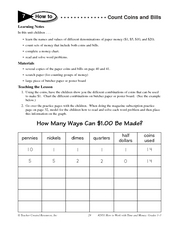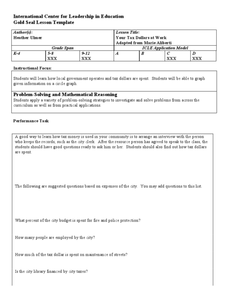Curated OER
How To: Count Coins and Bills
Students discover the names and values of different monetary denominations. In this money instructional activity, students examine the different combinations that money can be added in to find specified amounts. The students complete...
Curated OER
Counting Money
Students discover the importance of economics through Shel Silverstein's poem Smart. Students are introduced to the concept of earning money and using money to purchase necessary items, after becoming familiar with U.S. money.
Curated OER
Making Choices
Second graders explore financial decision making. In this introductory economics instructional activity, 2nd graders listen to the book Alexander, Who Used to be Rich Last Sunday by Judith Viorst, and discuss making financial choices...
Curated OER
Math -- Money
Young scholars identify a penny, nickel, dime, quarter and a half dollar. They examine the value of each coin and its equivalents (to quarter/dollar). After pairing up with a classmate, each one drills the other one on each coin.
Curated OER
Your Tax Dollars at Work
In order to understand how tax dollars are spent, young economists use given data and graph it on a circle graph. Circle graphs are highly visual and can help individuals describe data. A class discussion follows the initial activity.
Curated OER
Lemonade Stand: Making Money the Old-Fashioned Way
Young scholars run their own lemonade stand and are to figure out what to sell the lemonade at to gain the maximum profit.
Curated OER
Money Madness
Second graders review coins and their values. In this coin recognition lesson, 2nd graders review the coin values as they read 'Smart' by Shel Silverstein. Students use class computer demonstrations to identify the coin's names, worth,...
Curated OER
The Evolution of Arkansas Elementary Education
Fourth graders interview older citizens to discover earlier educational history. They write essays based on their interviews.







